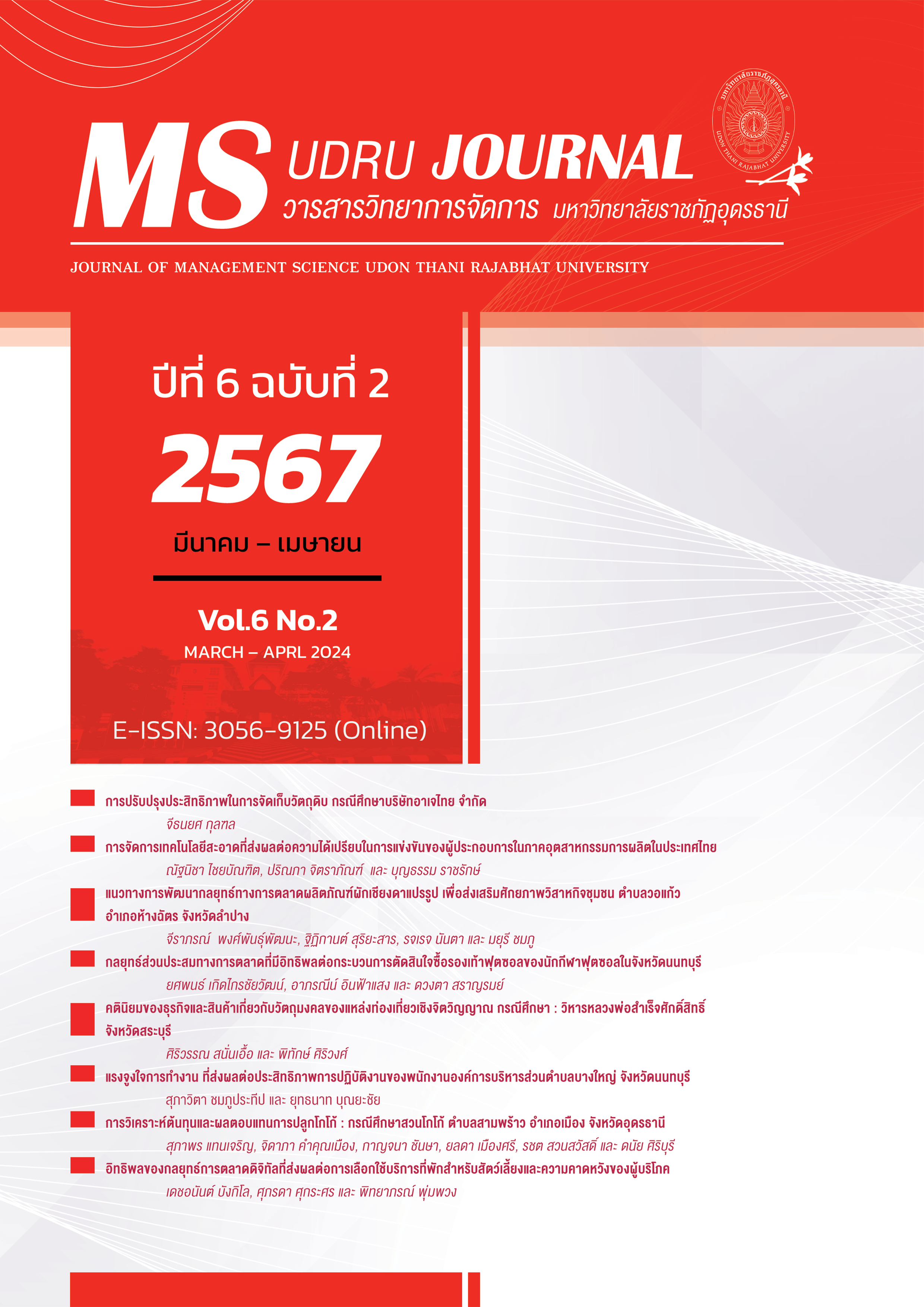THE IMPACT OF CLEAN TECHNOLOGY MANAGEMENT ON THE COMPETITIVE ADVANTAGE OF ENTREPRENEUR IN THE INDUSTRYSECTORIN THAILAND
Main Article Content
Abstract
At present, Thailand has no guidelines for environmental practices and business competitiveness. Economic growth and the manufacturing industry have a direct impact on the environment. Therefore, the business sector should be aware the importance of production operations with environmental measures. This research aimed to study the impact of clean technology management on the competitive advantage of the industrial sector in Thailand. Data were collected by questionnaires from 400 businesses in the industrial sector. Data analysis is based on the structural equation modeling (SEM). The results showed clean technology management in the production process has a positive impact on competitiveness in all aspects, including eg. Images Value Added Satisfaction As for clean technology product management, it has a positive impact on competitiveness in two side is image and satisfaction. For the performance side, there was a causal relationship but no statistically significant.
Article Details

This work is licensed under a Creative Commons Attribution-NonCommercial-NoDerivatives 4.0 International License.
บทความที่ได้รับการตีพิมพ์เป็นลิขสิทธิ์ของคณะวิทยาการจัดการ มหาวิทยาลัยราชภัฏอุดรธานี
ข้อความที่ปรากฏในบทความแต่ละเรื่องในวารสารวิชาการเล่มนี้ ไม่ใช่ความคิดเห็นและความรับผิดชอบของผู้จัดทำ บรรณาธิการ กองบรรณาธิการ และคณะวิทยาการจัดการ มหาวิทยาลัยราชภัฏอุดรธานี ความรับผิดชอบด้านเนื้อหาและการตรวจร่างบทความแต่ละเรื่องเป็นความคิดเห็นของผู้เขียนบทความแต่ละท่าน
References
กรมโรงงานอุตสาหกรรม, กระทรวงอุตสาหกรรม. (2564). เทคโนโลยีการผลิตที่สะอาด (Cleaner Technology-CT) สำหรับโรงงานอุตสาหกรรม. สืบค้นเมื่อ 20 กรกฎาคม 2564, จาก http://www2.diw.go.th/ctu.
กรมส่งเสริมคุณภาพสิ่งแวดล้อม, กระทรวงทรัพยากรธรรมชาติและสิ่งแวดล้อม. (2564). เทคโนโลยีสะอาด Clean Technology. สืบค้นเมื่อ 20 กรกฎาคม 2564, จาก https://datacenter.deqp.go.th/service-portal/g-green/greenlearningcenter/clean-technology/clean-technology/
ชัญญาภัค หล้าแหล่ง. (2558). ความสัมพันธ์เชิงสาเหตุและผลลัพธ์ของกลยุทธ์นวัตกรรมสีเขียว: หลักฐานเชิงประจักษ์ของธุรกิจอุตสาหกรรมการผลิตของไทยที่ได้รับการรับรองมาตรฐานสิ่งแวดล้อม ISO 14001. วิทยานิพนธ์ปริญญาปรัชญาดุษฎีบัณฑิต มหาวิทยาลัยศิลปกร.
วรดี จงอัศญากุล. (2554). การจัดการองค์กรอุตสาหกรรม. พิมพ์ครั้งที่ 2. กรุงเทพฯ: มหาวิทยาลัยเกษตรศาสตร์.
ศุภพงษ์ ปิ่นเวหา. (2561). การจัดการเทคโนโลยีสะอาดที่มีผลต่อความได้เปรียบในการแข่งขันและความยั่งยืนขององค์กรของธุรกิจอุปกรณ์ไฟฟ้าและอิเลกทรอนิกส์. วารสารบัณฑิตศึกษา มหาวิทยาลัยราชภัฏวไลยอลงกรณ์ ในพระบรมราชูปถัมภ์, 12(3), 184-196.
สำนักงานสภาพัฒนาการเศรษฐกิจและสังคมแห่งชาติ, สำนักนายกรัฐมนตรี. (2564). วารสารเศรษฐกิจและสังคม. สืบค้นเมื่อ 20 สิงหาคม 2564, จาก https://www.nesdc.go.th/ewt_w3c/main.php?filename=economic_magazine.
สัญญา ยิ้มศิริ, แววมยุรา คำสุข และ มรกต กำแพงเพชร. (2562). ตัวแบบสมการโครงสร้างของการจัดการโซ่อุปทานสีเขียว ผลการดำเนินงานด้านสิ่งแวดล้อม และผลการดำเนินงานด้านเศรษฐกิจที่มีผลต่อความได้เปรียบในการแข่งขันของอุตสาหกรรมการแปรรูปอาหารในประเทศไทย. รายงานวิจัยฉบับสมบูรณ์ คณะวิศวกรรมศาสตร์ มหาวิทยาลัยบูรพา.
เสาวลักษณ์ โงชาฤทธิ์. (2555). ผลกระทบของการจัดการเทคโนโลยีสะอาดที่มีต่อผลการดำเนินงานของธุรกิจสิ่งทอในประเทศไทย. วิทยานิพนธ์ปริญญาเศรษฐศาสตรมหาบัณฑิต, มหาวิทยาลัยมหาสารคาม.
อภิญญา วนเศรษฐ. (2559). แนวคิดทฤษฎีเศรษฐศาสตร์สิ่งแวดล้อมของคุซเน็ตส์ (Environmental Kuznets Curve). สืบค้นเมื่อ 15 สิงหาคม 2564, จาก https://www.stou.ac.th/stouonline/lom/data/sec/Lom21/home.html.
Alam, S.M.S., & Islam, K.M.Z. (2021). Examining the role of environmental corporate social responsibility in building green corporate image and green competitive advantage. International Journal of Corporate Social Responsibility, 6(8), 1-16.
Jay B. Barney. (1997). Gaining and Sustaining Competitive Advantage. (4th ed.). New Jersey: Pearson Education.
Jongsriwattanaporn, B., & Lalaeng, C. (2003). Causal Factor and Outcomes of Creating Competitive Advantages in the Digital Age of LMG Insurance Co., Ltd. Asian Administration and Management Review, 6(1), 117-129.
Klaprabchone, K., Chengseng, S., Prapho, T., Lissani, S., & Sangsawang, B. (2019). External Factors Affecting Sustainable Competitive-Advantage of Community Enterprises. Enterprises. Asian Administration and Management Review, 2(2), 126-135.
Nakwichian, P., & Suwannaphirom, S. (2003). The Success of Small and Medium Enterprises in Creating Competitive Advantages in Bangkok and Its Vicinity. Procedia of Multidisciplinary Research, 1(6), 14.
Richard B. Chase, F. Robert Jacobs, & Nicholas J. Aquilano. (2006). Operations Management for Competitive Advantage (11th ed.). New York: The McGraw-Hill.
Salem, M.A., Shawtari, F., Hussain, H.B.I., &Shamsudin, M.F. (2020). Environmental technology and a multiple approach of competitiveness. Future Business Journal, 6(17), 1-14.
Sharma, A., & Narula, S.A. (2020). What motivates and inhibits Indian textile firms to embrace sustainability. Asian Journal of Sustainability and Social Responsibility, 5(6), 1-23.
UN Environment Programme, (2021). Why do the Sustainable Development Goals matter?. In Sustainable Development Goals. https://www.unep.org/explore-topics/sustainable-development-goals/why-do-sustainable-development-goals-matter.
Vu, H.T., & Pham, L.C. (2016). A dynamic approach to assess international competitiveness of Vietnam’s garment and textile industry. Springer Plus, 5(203), 1-13.


